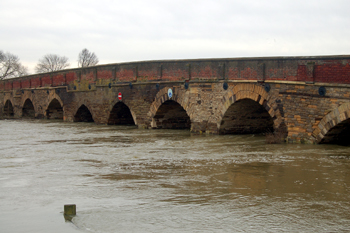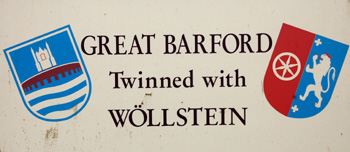The Parish of Great Barford in General

Great Barford Bridge March 2010
Landscape
Volume III of The Victoria County History for Bedfordshire was published in 1912. At that date the parish contained 2,843 acres of which 1,527.5 were used for arable farming and 1,030 acres were permanent grassland. There were just three acres of woodland.
Most of the parish is low-lying. The church stands at just 75 feet above sea-level and the junction of Bedford Road with the High Street just three feet higher. The ground rises in the north of the parish, away from the river, and the former windmill stands at about 170 feet above sea-level.
The solid, or underlying, geology is a mudstone called Oxford Clay, laid down in the warm, shallow seas of the Jurassic Period between 154 and 164 million years ago. Along the river the superficial geology is a band of alluvium - a mixture of sand, gravel, clay and silt. Most of the area of the village stands on river terrace deposits of sand and gravel but along most of Roxton Road and Green End Road the soil is clay. North and west of the village the soil is glacially deposited till.

Great Barford sign March 2010
Name
In their Place Names of Bedfordshire and Huntingdonshire of 1926 A. Mawer and F. M. Stenton comment: "This place name, with others of the same form, offers considerable difficulties". Three possibilities are offered "Bera's ford" where Bera is an otherwise unknown personal name, "bear's ford" or, most likely, "ford like a barn door" in other words wide and flat. Interestingly the Barford element in Little Barford seems to have a quite different meaning! The epiphet Great was added to Barford only in the 17th century. The name is first recorded in the Domesday Book of 1086 and there have been a few variations:
- Bereforde: 1086;
- Berford: 1257;
- Berfford: 1542;
- Bareford: 1545.

Great Barford church from the north-west October 2007
Administrative History
Great Barford lies in the Barford Hundred. It is an ancient parish and is bordered to the south-east by Blunham, south by Mogerhanger and Willington, west by Renhold, north by Wilden and north-east by Roxton. The village lies on the south-eastern side of the parish along the river Great Ouse, which forms the boundary with Blunham.
![Stocking rushes at Great Barford [Z50/5/36]](/CommunityHistories/GreatBarford/GtBarfordImages/Stocking rushes at Great Barford [Z50-5-36].jpg)
Stocking rushes at Great Barford [Z50/5/36]
Population
In the Domesday Book Great Barford is recorded as having a population of twenty one villagers, twenty five smallholders and eight slaves - a total of fifty four. These, of course, are just the heads of household and so the figure should probably be multiplied by a figure of at least four to account for wives and children, suggesting a total population of over two hundred, making it a large settlement for the time. By 1801, however, Great Barford was quite a modest village with a population of 431 though this grew steadily until the middle of the century when it fell back somewhat as economics forced people from the land and into towns. For the first half of the 20th century the population was quite stable then, between 1961 and 1971 it almost doubled with large amounts of new housing.
- 1801: 431;
- 1811: 577;
- 1821: 635;
- 1831: 731;
- 1841: 814;
- 1851: 865;
- 1861: 907;
- 1871: 847;
- 1881: 788;
- 1891: 746;
- 1901: 681;
- 1911: 726;
- 1921: 760;
- 1931: 775;
- 1951: 760;
- 1961: 788;
- 1971: 1,495;
- 1981: 1,741;
- 1991: 1,718;
- 2001: 1,859;
- 2011: 2,003.